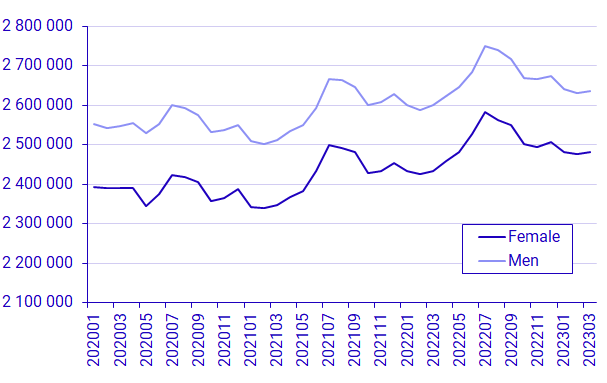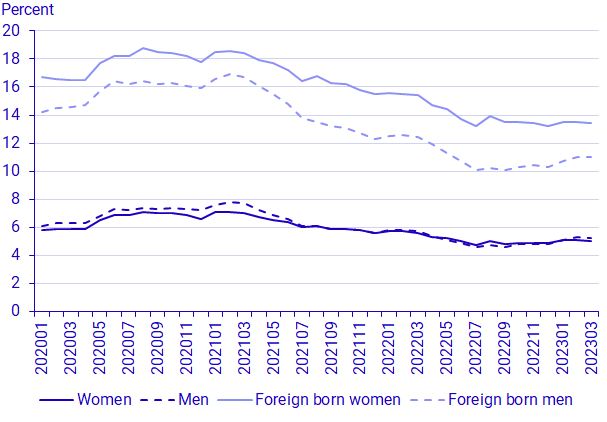Population by Labour market status, 1st quarter 2023
Employment continued to increase in the first quarter of 2023
Statistical news from Statistics Sweden 2023-05-31 8.00
People in employment aged 15 to 74 numbered 5 115 000 in the first quarter of 2023. This is an increase of 89 000 people compared to the same period of 2022. In the 16 to 64 age range, 264 000 people were unemployed. This equals a share of 5.1 percent expressed as a percentage of the labour force and a decrease of 0.6 percentage points from the first quarter of 2022.
Statistics Sweden launched the product “Labour market status of the population” (BAS) in May 2022. The purpose of BAS is to provide information on labour supply in Sweden by month, quarter and year. Initially, BAS are “statistics under development” but with plans to present them as official statistics eventually. This presentation concerns preliminary statistics, monthly and quarterly, for the period January–March 2023. For more information, see Definitions and explanations.
People in employment
The number of people in employment aged 15 to 74 increased in the first quarter of 2023 by 89 000 compared with the same period of 2022, amounting to 5 115 000. Fewer women than men were employed. A total of 2 479 000 women and 2 635 000 men were employed.

The employment rate – the number of employed people in relation to the population – was 66.3 percent among women and 67.9 percent among men. Compared to the first quarter of 2022, the employment rate increased by 1.0 percentage points for women and 0.6 percentage points for men. The employment rate is largely affected by the demographic composition of the population, which is of significance when comparing municipalities, for example. Young and older people tend to have a lower employment rate and are present in other labour market status categories.
The unemployed
The number of unemployed people aged 16 to 64 in the first quarter of 2023 was 264 000. This is a decrease of 27 000 people compared with the first quarter of 2022. The number of unemployed women was 127 000 and the number of unemployed men was 137 000. The relative unemployment rate – the proportion of unemployed people in relation to the labour force – was 5.1 percent for women and 5.2 percent for men. This corresponds to a reduction in unemployment among both women and men of 0.6 percentage points compared with the same period of 2022.
Unemployment is higher among foreign born people than among those born in Sweden. Unemployed foreign born people aged 16 to 64 numbered 152 000 in the first quarter of 2023. This is a decrease of 17 000 people compared with the first quarter of 2022. The number of unemployed foreign born women was 81 000 and the number of unemployed foreign born men was 72 000. The relative unemployment rate was, among foreign born people, 13.5 percent for women and 10.9 percent for men. This equals a reduction in unemployment among women of 2.0 percentage points, and 1.6 percentage points among men compared with the same period of 2022.

Definitions and explanations
BAS, Labour market status of the population, presents statistics based on administrative data concerning aspects such as the number of people in employment, unemployed people and people outside the labour force for the registered population aged 15 to 74. The statistics can be used to describe current status, but also the progression over time. They illuminate both the entire population and smaller groups, such as detailed age groups at the municipal level.
The statistics contain estimates of the number of people broken down by labour market status: Employed, unemployed, student, pensioner, sick and others, with the labour force consisting of employed people and the unemployed. The definition of labour market status is hierarchical, which means that a person can only be assigned one labour market status, and it is determined according to the order of precedence above.
The statistics are by month. Quarterly and annual data is calculated as the average of the months included.
Feel free to use the facts from this statistical news but remember to state Source: Statistics Sweden.
